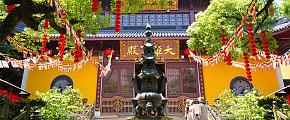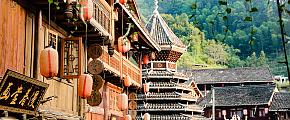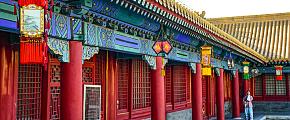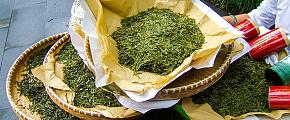Traditional Chinese Painting
Chinese painting is also called traditional Chinese painting. Just as its name implies it is painted with traditional Chinese painting tools in accordance with the Chinese people's aesthetic standards. As an important part of traditional Chinese culture and an invaluable treasure of the Chinese nation, it has a long history and fine traditions in the field of art in the world. And it has taken a distinctive course or attitude of its own. Here we give an outline of this painting and take a simple example of drawing Chinese painting.
Characteristics
Unlike Western painting, traditional Chinese painting has its distinctive characteristics. It does not emphasize the one-point perspective and the change of light and colors on objects. It is free in describing the objects and lays more emphasis on the painter's sentiment and the overall arrangement of the picture, so this is a good point that "the occidental painting is previous art, but Chinese painting belongs to expressionist art".
By means of artistic expression, traditional Chinese painting can be divided into elaborate-style painting, liberal-style painting, and elaborate-liberal-style painting. The elaborate-style painting is drawn and colored orderly and meticulously with the painting brush, it uses extremely exquisite brushwork to describe the objects. Comparatively, the liberal-style painting employs free and concise strokes and ink to describe the appearance and spirit of the objects and express the painter's sensation. it is highly synoptically, and its connotative artistic conception is not conveyed by the overall, but by the partial. When drawing a liberal-style painting, the painter is required to put the painting brush to paper precisely, and his every stroke must be skillful and with high proficiency to express the spirit of the picture. As for The elaborate-liberal-style painting, it is an integrated application of the techniques of both elaborate-style painting and liberal-style painting.
The skill of using strokes and ink is an important part of the formation of Chinese painting. Its strokes have stressed the varieties of thick and thin, swiftness and slowness, with syncopated cadence, turning and breaking, square and round to express the tactile sensation of the objects. In general, Chinese painting uses ink is subtle in the combination of shade and light as entirely shade or light is not good for conveying the spirit of the picture. Its shade part looks wonderful but not mechanical and the light part is delicately beautiful but not gloomy.
Chinese painting is particular in applying colors. Its colors are from natural mineral materials and animal shells. They can bear all kinds of weather and not fade, and they are often applied to the picture level. This way of applying colors pursues the original colors of the objects, the change of light and shadow does not often appear.
Tools for Chinese Painting
The artistic expression of Chinese painting differs from that of Western painting because of its tools for painting. To draw a Chinese painting, a writing brush, ink stick, rice paper, and ink stone are necessary. Especially for rice paper ( Xuan paper) is the best tool for Chinese painting because it has a nice texture to allow the writing brush, wet with Chinese ink and held in a well-trained hand, to move freely on it, making strokes varying from shade to light, from real to imaginative.
Materials for Chinese painting
Generally, Chinese painting is drawn on rice paper. But in the fans, porcelain, bowls, and dishes, you also find beautiful Chinese pictures when you shop in the tourist shopping streets or eat in some specialty restaurants. Besides, the Chinese pictures are also drawn on the silk, screens, and even on many ancient tombs' walls.
Shapes of Chinese painting
Chinese painting is diverse in its shapes. Except for the mural, there are traverse, vertical, square, round, and flat shapes, it also differs in size and length.
Combination of poem, calligraphy, painting and signet
Chinese painting shows the perfect union of poems, calligraphy, painting and signet. Generally, Many Chinese painters are poets as well as calligraphers. He often adds a poem to it personally and stamps his various signets on the painting after he finishes it. The combination of the four makes the painting look more integrated, perfect, and beautiful, which can bring the appreciator aesthetic pleasure.
Mounting
Mounting a Chinese picture is for keeping and housing for a long time because many Chinese pictures are drawn on breakable rice paper or painting silk. The traditional Chinese mounting technique is diverse in forms, but commonly, the picture has backed a piece of paper up and then purfles it with the ninon, silk, or paper. Compared with a not-mounted picture, the mounted picture is more substantial, beautiful, and convenient for collection and appreciation.
Themes
According to the different delineative subject matters, the themes of traditional Chinese painting can be classified into three branches, i.e., human figures, landscapes, and flowers and birds. For example, the painting of ladies, the painting of mountains, and the painting of insects and fish belong to the three branches, respectively.
Learn to draw a simple traditional Chinese painting
Before you start your Chinese journey, you can try here to learn how to draw a chick in traditional Chinese painting; you may find some joy in it. Indeed, if you want to learn more about Chinese painting you can visit the Chinese painting shops in the ancient city of Lijiang or those on West Street in Yangshuo because sometimes the artists draw pictures in their shops or on the street. And if you want to appreciate or purchase some, you can look for the galleries or painting shops through your local guide when doing Guilin tours.
See the TOP10 China Tours or start tailor-making your own with us.
What Our Clients Say
"Great Customized Service", "Trip of A Lifetime", "Exceed All Expectations"







